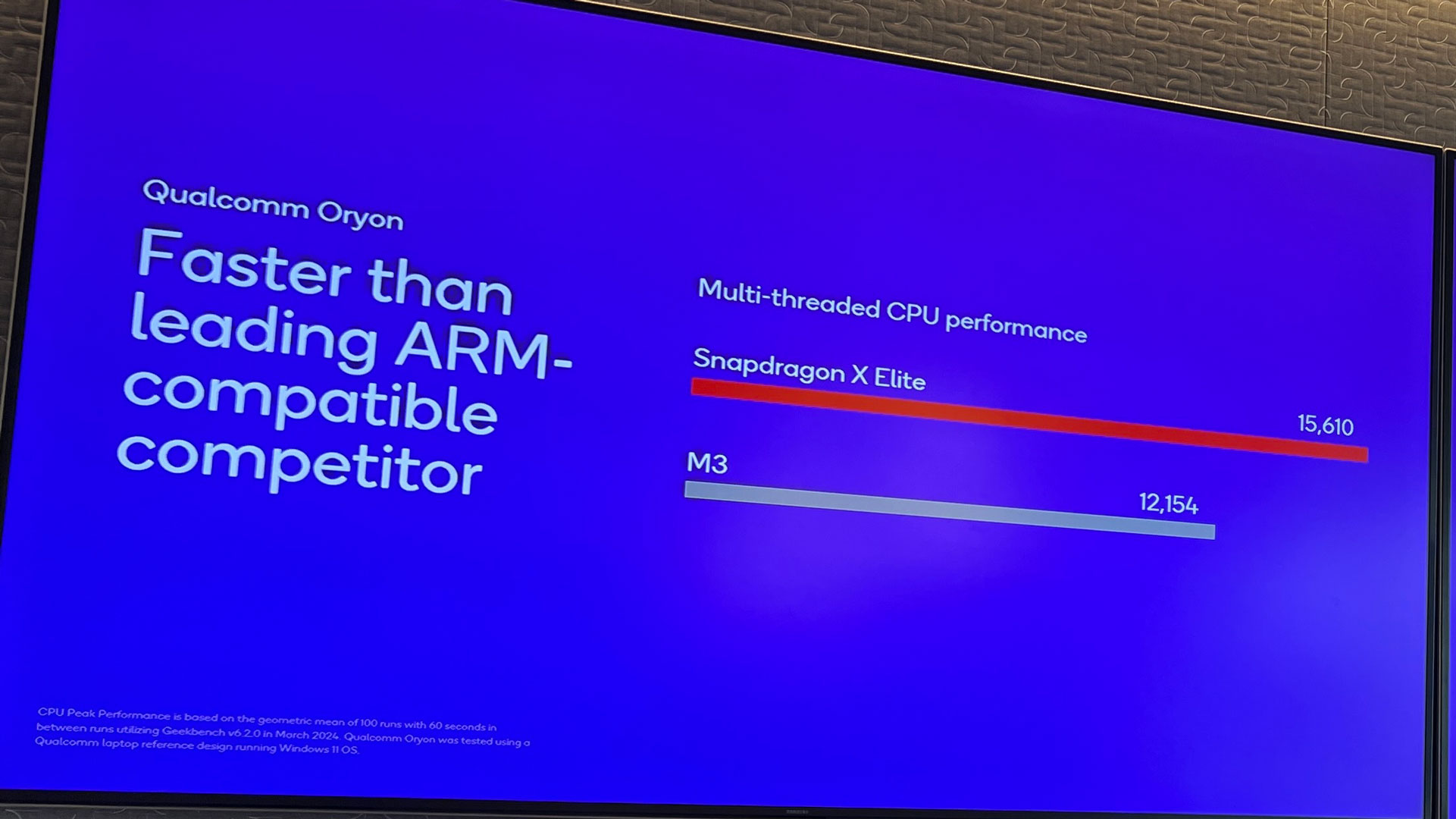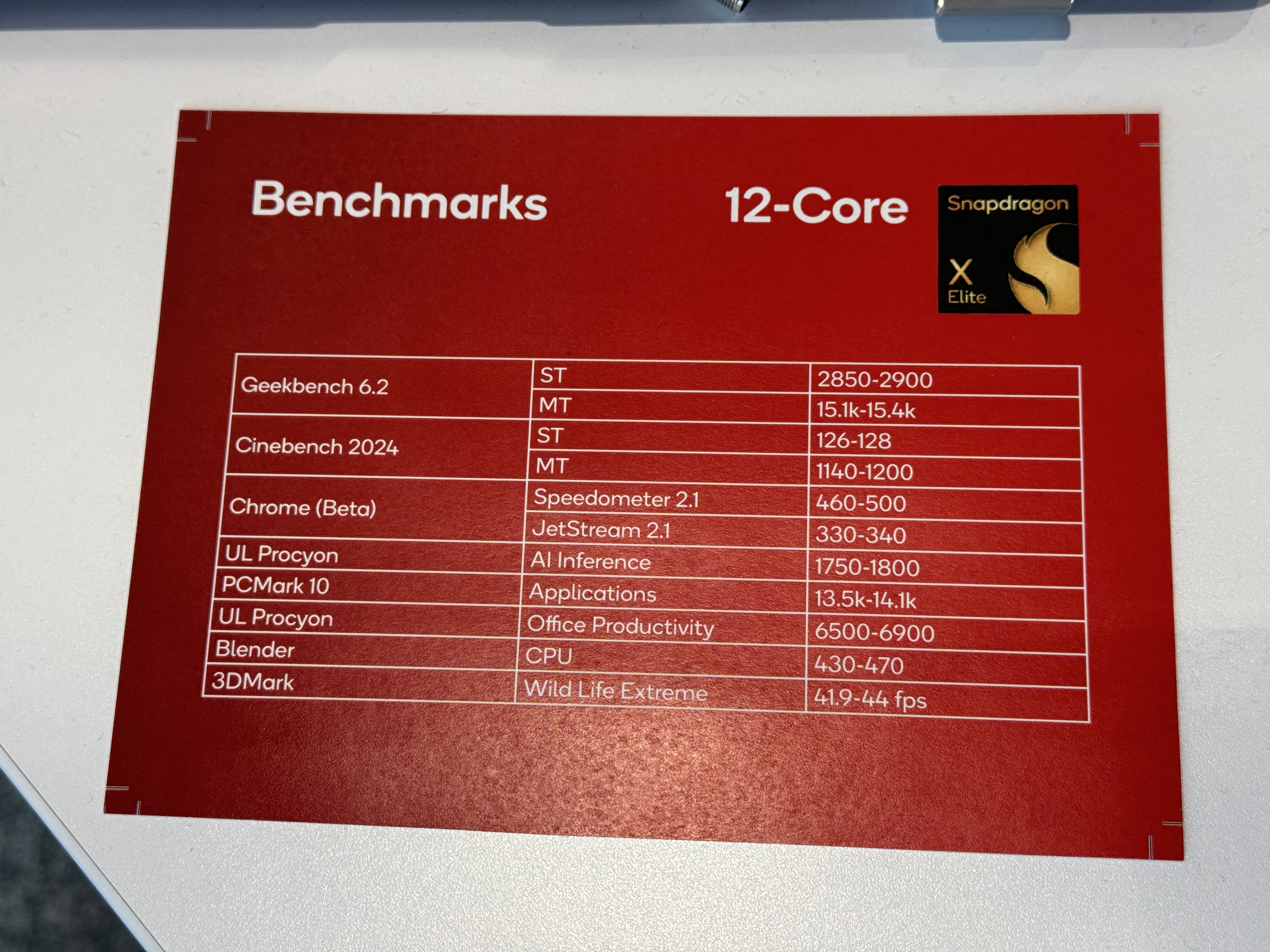It feels like we’ve been talking about Snapdragon X Elite for a while. It was announced back in October and has seen its fair share of performance leaks. But, for the first time, Qualcomm let us run some tests on the chip.
At a press event in New York, I was able to actually take a look at some laptops using the X Elite in Qualcomm’s striking red reference design. Of course, there are some caveats — the tests were pre-selected and preinstalled. Everything was running in Qualcomm’s carefully prepared environment. There were many laptops, but of the ones I checked, they were running on Windows 11’s balanced performance profile.
In fact, there were multiple configurations going around. Most interesting is that there were three versions of Qualcomm’s processor floating around:
- Snapdragon X Elite X1E80100, paired with 16GB of RAM
- Snapdragon X Elite X1E84100, paired with 64GB of RAM
- Snapdragon X Elite X1E80100, paired with 32GB of RAM (this machine was being used for AI demos)
The first two were on easily accessible computers with the benchmarks on them. The X1E80100 was described by Qualcomm reps as more of a standard version of the chip, with Oryon cores running at 3.4 GHz, while the X1E84100 was touted as a binned version, going up to 3.8 GHz. It’s unclear how Qualcomm will go about naming these configurations for the mass market.
Updated Intel and Apple Comparisons
Qualcomm took its time to update its own claims now that Intel has released its Core Ultra chips and Apple has moved onto M3.
In terms of Apple comparisons, Qualcomm was a bit thin, only covering multi-threaded CPU performance in Geekbench 6. Qualcomm claims the X Elite beats the M3, 15,610 to 12,154. Single-threaded performance wasn’t mentioned, nor graphics. And Qualcomm didn’t bring up the M3 Pro or M3 Max, either.

The Intel comparisons were more detailed and more damning. Qualcomm spent plenty of time going after the Core Ultra 7 155H (tested in an Asus Zenbook 14 OLED). In single-threaded performance, Qualcomm says the X Elite is 54% faster than the Ultra 7 155H using the same amount of power, and that it matches the Ultra’s peak performance using 65% less power.
In multi-threaded performance, it claims 52% faster CPU performance at the same power or matching peak performance at 60% less power.
Qualcomm is also claiming some victories against the Core Ultra 9 185H (tested in an Asus ROG Zephyrus G16). In single-thread performance, Qualcomm claims 51% faster CPU performance at the same power and matches peak performance using 65% less power. With multi-threaded performance, those numbers become 41% and 58%.
On the GPU side, Qualcomm claims that its graphics are 36% faster than what you find in the Core Ultra 7 155H at the same power, and that it meets peak performance at 50% less power. These comparisons weren’t made for M3 or Ultra 9.

Additionally, Qualcomm claims that the Snapdragon X Elite will offer “breakthrough” battery life, though the company hasn’t said what size batteries they will use (or if OEMs will have a variety of choices). Still, the company claims it can provide up to 40% longer battery life using Office 365 apps, or more than twice as long when on video calls. Since Qualcomm isn’t shipping its reference design, I really want to test this myself. It could make or break the whole experience.

Qualcomm also claimed that its chip is faster than the Ultra 7 155H at web browsing (20% faster in Chrome, 57% faster in Edge, 15% faster in Brave) according to the Speedometer 2.1 test, and suggests that app speeds range from 7% faster (7-Zip) to 69% faster (Spotify).
One question I don’t have the answer to is which version of the Snapdragon X Elite Qualcomm was used for these benchmarks. X1E80100, X1E84100, or something else entirely?
A bit of hands-on time
Qualcomm had some of its reference models out, with the following available for me to easily check out:
Snapdragon X Elite X1E80100 (3.4 GHz), paired with 16GB of RAM:

Snapdragon X Elite X1E84100 (3.8 GHz), paired with 64GB of RAM:

Each of them had a corresponding benchmark card with what to expect. I’ll give Qualcomm this – when I did run those preinstalled tests, they largely hit the mark, and often times their supplied numbers were even a bit under. Only in one case of Geekbench on the 3.4 GHz system did I get lower numbers, but everything else fell in range.
The company also had a unit to try some gaming on, with Redout, Controland Baldur’s Gate 3 preinstalled and running through emulation. I got to watch others try Redout and play a bit of early-game Control myselfbut no one got to Baldur’s Gatepartially due to a crowded room of press trying it and limited time. Redout was running at just under 40 frames per second. Early, non-combat stages of Control also ran around 40 fps on low settings, though they did occasionally fall below 30 fps suddenly.
Other, more controlled demos included some guided artificial intelligence tools using the NPU. They’re similar to what we saw Intel tout for Core Ultra, like using a plugin with Audacity to generate snippets of music using SNAP rather than OpenVino, as well as VSCode writing code based on prompts.
While everything looked good in Qualcomm’s setup on Qualcomm’s machines, we’ll really need to test the Snapdragon X Elite (in all of its configurations) on retail machines from Qualcomm’s OEM partners on our own. Currently, that’s still set for a murky mid-2024, but if it makes Windows on Arm an attractive option, it will be very exciting.







